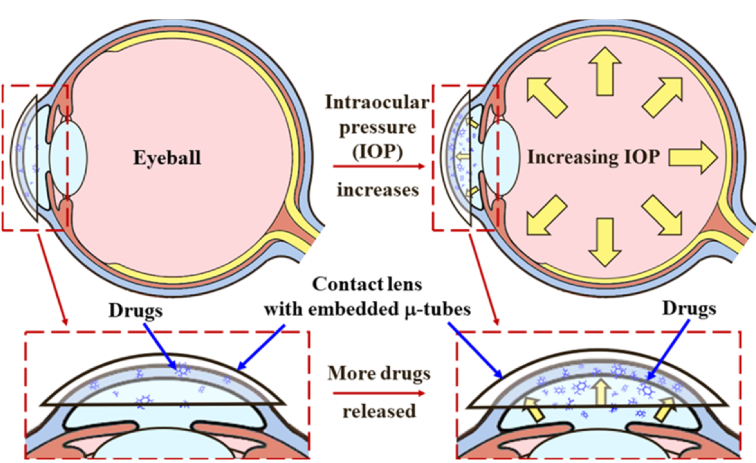|
Stretch-triggered Drug Delivery
Stretch-triggered drug delivery is a method of controlled drug delivery stimulated by mechanical forces. The most commonly used materials for stretch-triggered autonomous drug release systems are Hydrogel, hydrogels and Elastomer, elastomers. This method of drug delivery falls in the category of stimuli-responsive drug delivery systems which include pH, temperature, and redox-responsive systems. Mechanical forces occur naturally throughout the human body therefore, stretch-triggered drug delivery systems may be used to autonomously deliver medications to the body when needed. The use of autonomous drug release systems reduces outcomes such as delays in receiving treatment and inaccurate dosages. Autonomous drug release systems induced by stretch apply to drugs such as Antimicrobial, antimicrobial agents, cardiovascular medication, and Chemotherapy, anticancer drugs. Personalized medicine, Theranostic agents are also applicable to this drug delivery system, allowing for simultaneous ... [...More Info...] [...Related Items...] OR: [Wikipedia] [Google] [Baidu] |
Drug Delivery
Drug delivery involves various methods and technologies designed to transport pharmaceutical compounds to their target sites helping therapeutic effect. It involves principles related to drug preparation, route of administration, site-specific targeting, metabolism, and toxicity all aimed to optimize efficacy and safety, while improving patient convenience and compliance. A key goal of drug delivery is to modify a drug's pharmacokinetics and specificity by combining it with different excipients, drug carriers, and medical devices designed to control its distribution and activity in the body. Enhancing bioavailability and prolonging duration of action are essential strategies for improving therapeutic outcomes, particularly in chronic disease management. Additionally, some research emphasizes on improving safety for the individuals administering the medication. For example, microneedle patches have been developed for vaccines and drug delivery to minimize the risk of ... [...More Info...] [...Related Items...] OR: [Wikipedia] [Google] [Baidu] |
Transdermal
Transdermal is a route of administration wherein active ingredients are delivered across the skin for systemic distribution. Examples include transdermal patches used for medicine delivery. The drug is administered in the form of a patch or ointment that delivers the drug into the circulation for systemic effect. Techniques Obstacles Although the skin is a large and logical target for drug delivery, its basic functions limit its utility for this purpose. The skin functions mainly to protect the body from external penetration (by e.g. harmful substances and microorganisms) and to contain all body fluids. There are two important layers to the human skin: (1) the epidermis and (2) the dermis. For transdermal delivery, drugs must pass through the two sublayers of the epidermis to reach the microcirculation of the dermis. The stratum corneum is the top layer of the skin and varies in thickness from approximately ten to several hundred micrometres, depending on the region of the ... [...More Info...] [...Related Items...] OR: [Wikipedia] [Google] [Baidu] |
In Vivo
Studies that are ''in vivo'' (Latin for "within the living"; often not italicized in English) are those in which the effects of various biological entities are tested on whole, living organisms or cells, usually animals, including humans, and plants, as opposed to a tissue extract or dead organism. Examples of investigations ''in vivo'' include: the pathogenesis of disease by comparing the effects of bacterial infection with the effects of purified bacterial toxins; the development of non-antibiotics, antiviral drugs, and new drugs generally; and new surgical procedures. Consequently, animal testing and clinical trials are major elements of ''in vivo'' research. ''In vivo'' testing is often employed over ''in vitro'' because it is better suited for observing the overall effects of an experiment on a living subject. In drug discovery, for example, verification of efficacy ''in vivo'' is crucial, because ''in vitro'' assays can sometimes yield misleading results with drug c ... [...More Info...] [...Related Items...] OR: [Wikipedia] [Google] [Baidu] |
In Vitro
''In vitro'' (meaning ''in glass'', or ''in the glass'') Research, studies are performed with Cell (biology), cells or biological molecules outside their normal biological context. Colloquially called "test-tube experiments", these studies in biology and its subdisciplines are traditionally done in labware such as test tubes, flasks, Petri dishes, and microtiter plates. Studies conducted using components of an organism that have been isolated from their usual biological surroundings permit a more detailed or more convenient analysis than can be done with whole organisms; however, results obtained from ''in vitro'' experiments may not fully or accurately predict the effects on a whole organism. In contrast to ''in vitro'' experiments, ''in vivo'' studies are those conducted in living organisms, including humans, known as clinical trials, and whole plants. Definition ''In vitro'' (Latin language, Latin for "in glass"; often not italicized in English usage) studies are conducted ... [...More Info...] [...Related Items...] OR: [Wikipedia] [Google] [Baidu] |
Quinine
Quinine is a medication used to treat malaria and babesiosis. This includes the treatment of malaria due to ''Plasmodium falciparum'' that is resistant to chloroquine when artesunate is not available. While sometimes used for nocturnal leg cramps, quinine is not recommended for this purpose due to the risk of serious side effects. It can be taken by mouth or intravenously. Malaria resistance to quinine occurs in certain areas of the world. Quinine is also used as an ingredient in tonic water and other beverages to impart a bitter taste. Common side effects include headache, tinnitus, ringing in the ears, vision issues, and sweating. More severe side effects include deafness, thrombocytopenia, low blood platelets, and an irregular heartbeat. Use can make one more prone to sunburn. While it is unclear if use during pregnancy carries potential for fetal harm, treating malaria during pregnancy with quinine when appropriate is still recommended. Quinine is an alkaloid, a natural ... [...More Info...] [...Related Items...] OR: [Wikipedia] [Google] [Baidu] |
Angiogenesis
Angiogenesis is the physiological process through which new blood vessels form from pre-existing vessels, formed in the earlier stage of vasculogenesis. Angiogenesis continues the growth of the vasculature mainly by processes of sprouting and splitting, but processes such as coalescent angiogenesis, vessel elongation and vessel cooption also play a role. Vasculogenesis is the embryonic formation of endothelial cells from mesoderm cell precursors, and from neovascularization, although discussions are not always precise (especially in older texts). The first vessels in the developing embryo form through vasculogenesis, after which angiogenesis is responsible for most, if not all, blood vessel growth during development and in disease. Angiogenesis is a normal and vital process in growth and development, as well as in wound healing and in the formation of granulation tissue. However, it is also a fundamental step in the transition of tumors from a benign state to a malign ... [...More Info...] [...Related Items...] OR: [Wikipedia] [Google] [Baidu] |
Esophagus
The esophagus (American English), oesophagus (British English), or œsophagus (Œ, archaic spelling) (American and British English spelling differences#ae and oe, see spelling difference) all ; : ((o)e)(œ)sophagi or ((o)e)(œ)sophaguses), colloquially known also as the food pipe, food tube, or gullet, is an Organ (anatomy), organ in vertebrates through which food passes, aided by Peristalsis, peristaltic contractions, from the Human pharynx, pharynx to the stomach. The esophagus is a :wiktionary:fibromuscular, fibromuscular tube, about long in adults, that travels behind the trachea and human heart, heart, passes through the Thoracic diaphragm, diaphragm, and empties into the uppermost region of the stomach. During swallowing, the epiglottis tilts backwards to prevent food from going down the larynx and lungs. The word ''esophagus'' is from Ancient Greek οἰσοφάγος (oisophágos), from οἴσω (oísō), future form of φέρω (phérō, "I carry") + ἔφαγον ( ... [...More Info...] [...Related Items...] OR: [Wikipedia] [Google] [Baidu] |
Transfection
Transfection is the process of deliberately introducing naked or purified nucleic acids into eukaryotic cells. It may also refer to other methods and cell types, although other terms are often preferred: " transformation" is typically used to describe non-viral DNA transfer in bacteria and non-animal eukaryotic cells, including plant cells. In animal cells, transfection is the preferred term, as the term "transformation" is also used to refer to a cell's progression to a cancerous state (carcinogenesis). Transduction is often used to describe virus-mediated gene transfer into prokaryotic cells. The word ''transfection'' is a portmanteau of the prefix ''trans-'' and the word "infection." Genetic material (such as supercoiled plasmid DNA or siRNA constructs), may be transfected. Transfection of animal cells typically involves opening transient pores or "holes" in the cell membrane to allow the uptake of material. Transfection can be carried out using calcium phosphate (i.e. ... [...More Info...] [...Related Items...] OR: [Wikipedia] [Google] [Baidu] |
Antibiotic
An antibiotic is a type of antimicrobial substance active against bacteria. It is the most important type of antibacterial agent for fighting pathogenic bacteria, bacterial infections, and antibiotic medications are widely used in the therapy, treatment and antibiotic prophylaxis, prevention of such infections. They may either bactericide, kill or bacteriostatic agent, inhibit the growth of bacteria. A limited number of antibiotics also possess antiprotozoal activity. Antibiotics are not effective against viruses such as the ones which cause the common cold or influenza. Drugs which inhibit growth of viruses are termed antiviral drugs or antivirals. Antibiotics are also not effective against fungi. Drugs which inhibit growth of fungi are called antifungal drugs. Sometimes, the term ''antibiotic''—literally "opposing life", from the Greek language, Greek roots ἀντι ''anti'', "against" and βίος ''bios'', "life"—is broadly used to refer to any substance used against ... [...More Info...] [...Related Items...] OR: [Wikipedia] [Google] [Baidu] |
Glaucoma Medication
Glaucoma medication is divided into groups based on chemical structure and pharmacologic action. The goal of currently available glaucoma therapy is to preserve visual function by lowering intraocular pressure (IOP) in patients that have an increased intraocular pressure. Medical uses Agents in common clinical use include: * Prostaglandin analogs * Parasympathomimetic (miotic) agents, including cholinergic and anticholinesterase agents * Carbonic anhydrase inhibitors (oral and topical) * Adrenergic antagonists (nonselective and selective Beta1-antagonists) * Alpha 2 agonists * Hyperosmotic agents * Nitric oxide donators * Rho kinase inhibitors When comparing people with primary open-angle glaucoma and ocular hypertension, medical intraocular pressure lowering treatment slowed down the progression of visual field loss. Comparison table Combinations Fotil is a combination drug consisting of:FASS (drug formulary)Fotil Retrieved 2015-02-17 *Pilocarpine, a parasympathomime ... [...More Info...] [...Related Items...] OR: [Wikipedia] [Google] [Baidu] |








